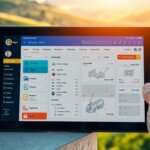Nearly 70% of buyers say they spend more when conversations feel seamless across channels. That single fact changed how I design outreach for my HVAC business.
I use light-touch automation to keep people informed without sounding robotic. Simple alerts—appointment confirmations, in-route texts, and tune-up reminders—help reduce no-shows and shorten service windows.
My communication strategy focuses on real needs: tech ETAs, pricing clarity, and easy next steps. This keeps my team aligned and lets CSRs and techs handle the tough calls while routine updates flow automatically.
Coordinating marketing, service updates, and support makes the whole journey smoother. The result: faster scheduling, higher estimate conversion, and more maintenance plan sign-ups that build long-term trust.

Key Takeaways
- Light automation keeps customers informed without sacrificing a friendly tone.
- A clear communication strategy cuts no-shows and shrinks service windows.
- Coordinated messages across touchpoints boost scheduling and sales.
- Routine updates free staff to focus on complex support moments.
- Measure impact with first response time, CSAT, and conversion metrics.
Why customer communication defines today’s HVAC client experience
Today, quick, clear updates shape whether people book and stay loyal to a local HVAC brand. I see homeowners expect fast answers, flexible channels, and consistent info across every touchpoint.
What I’m seeing in the field: faster, friendlier, more connected service
I let clients pick how they want to hear from me—phone for urgent issues, messaging for ongoing threads, and email for detailed invoices. That choice keeps the interaction personal and reduces repeats.
Letting people self-serve routine tasks cuts time to schedule and speeds first responses. When lines are busy, chat or SMS keeps things moving without friction.
Stats that matter right now: what consumers expect in 2025
Data backs this up: Zendesk and Salesforce show most buyers value seamless conversational experiences and often spend more when helped on the channel they’re using. Omnisend found big lifts when brands use three or more channels.
In short, mastering consistent channels across social media, phone, and email turns routine service into a competitive business advantage.
Customer communication: clear definitions for HVAC teams
Clear, consistent messaging keeps every job on time and reduces back-and-forth across my teams.
I define customer communication as every message and interaction my HVAC brand has across the lifecycle — from first inquiry and booking to post-service follow-ups and renewal reminders.
Customer communication management (CCM) is the discipline and management layer that lets me orchestrate messages, channels, templates, routing, and analytics in one place.
How CCM helps my field teams
With a unified platform, estimators, dispatch, and support see the same history and context. That shared information reduces repetitive questions and speeds approvals.
I use CCM to standardize tone, ensure compliance, and scale consistency without losing a personal touch. Separating message creation from delivery lets me update scripts or add SMS templates without disrupting the field.
Result: fewer missed appointments, faster estimate sign-offs, and higher acceptance of maintenance plans — a practical strategy that improves the service experience for everyone.
The business case: revenue, retention, and reputation gains
Every message I send is a small investment in revenue, retention, and reputation.
From first call to lifelong client: tying the path to value
Fast, clear replies speed scheduling, which means more booked jobs and steadier cash flow. Zendesk finds 77% of leaders say deeper personalization raises retention. Nielsen shows 88% trust peer recommendations.
I map the customer journey to spot moments where a single follow-up lifts ticket size. A timely financing link, a maintenance reminder, or a tailored offer nudges homeowners toward upgrades instead of a one-off repair.
How seamless conversations grow ticket size and repeat service
Omnichannel outreach drives orders: studies report up to a 494% higher order rate and 70% higher spend when conversations stay seamless. I use post-service messages to offer plans and IAQ add-ons in a helpful way.
Better routing and customer communication management reduce friction, recover stalled estimates, and increase engagement. I track interactions and outcomes so I can refine messages and prioritize the opportunities that move the needle.
Omnichannel communication channels that HVAC clients actually use
Choosing the right channel at the right moment cuts back-and-forth and shows respect for people’s time. I map each touchpoint to a clear use case so work flows and expectations match.
Phone for urgency, messaging for continuity, email for depth
I push the phone for emergencies—no heat in January, gas smells, or active leaks—because urgency and empathy matter most. Callback features keep a caller’s place in line and reduce hold-time frustration.
I use messaging (SMS or WhatsApp) to keep context alive: tech en route updates, gate codes, photos from the job, and quick approvals without repeating details.
Email handles depth: detailed quotes, warranty terms, and post-service docs that customers can save for later. Ninety-five percent of marketers report email meets long-form goals, so I rely on it for lasting records.

Live chat and SMS for real-time scheduling and updates
Live chat answers website questions fast. Agents can handle multiple threads while chatbots triage basic issues and route complex ones to a human for support.
SMS scheduling links cut back-and-forth by letting customers pick a slot and confirm instantly. That reduces calls and speeds bookings.
Social media and reviews to monitor sentiment and engage
I watch social media for public questions and feedback. I thank reviewers, answer simple posts, and move sensitive topics into private messages to resolve issues quickly.
In-person touchpoints that still build trust on-site
Face-to-face moments matter. Shoe covers, clear explanations, and written estimates anchor trust. I make sure what I promise online matches what my tech delivers on-site.
Every interaction is logged so the next contact starts with context, not a blank slate. That prevents unnecessary channel switching and keeps the experience smooth.
Automation that feels human: practical HVAC use cases
Automation can feel personal when it solves a problem before anyone asks. I focus on simple, timely alerts and friendly triage so homeowners get answers fast and my team spends time on the hard work.
Proactive alerts: service windows, tech en route, and weather-driven reminders
I send appointment confirmations, morning-of service windows, and “tech en route” messages with a GPS ETA. These alerts cut down “Where are you?” calls and save everyone time.
I also schedule weather-driven reminders—heatwave AC checklists or freeze warnings—so customers feel looked after in real time.
AI chatbots for triage, with easy escalation to a human
My AI chatbot works 24/7 to route FAQs like “Do you service my area?” or “Do you install heat pumps?” It collects just enough details and escalates to a scheduler when needed. Banks and fintech firms use similar virtual assistants with human handoff, and that model reduces wait times while keeping empathy in tough calls.
Automated follow-ups: invoices, maintenance plans, and reviews
After a job I automate invoices, payment links, tailored maintenance offers, and a quick review request. I trigger parts-status updates and reschedule links so customers can adjust without calling support.
I keep humans in the loop for complex diagnostics and warranty disputes. Then I review which messages perform best and tune send times so automation feels helpful, not spammy.
I unify these automation solutions across platforms so chat, SMS, and email share the same record. That single view improves interactions and keeps communication consistent across channels.
Personalization and segmentation across channels
Using simple details about a system and its history lets me send timely notes that feel useful, not salesy.
59% of consumers expect brands to use collected data to personalize the experience, and 68% want that across touchpoints. I lean on that expectation to make messages relevant and helpful.
Using data ethically to tailor messages and timing
I collect only the fields I need, store them securely, and give homeowners clear choices about frequency and channels. That builds trust and keeps outreach welcome.
My playbooks record consent and preference settings so every team member follows the same rules. I test send times and phrasing to raise engagement and lower opt-outs.
Segmenting by system type, age, region, and service history
I group owners by equipment—gas furnace versus heat pump—plus age and past repairs. That lets me surface replacement planning for older systems and maintenance tips for new installs.
I also segment by climate region and season. Messages about freeze protection go to cold areas; summer AC checks go to hot zones. The result is a better experience and fewer irrelevant offers.
Customer communication best practices for HVAC operations
I build processes so folks don’t have to switch channels to get an answer. Meeting people where they started reduces friction and raises satisfaction.
Meet customers on their channel of choice—don’t force channel switching
Only 42% of businesses support two or more channels. I resolve issues on the original channel when possible. That lowers repeat contacts and keeps callers from bouncing between phone, chat, and email.
Keep a consistent tone of voice: professional, friendly, clear
I train my teams to use short, human phrases so automated texts and emails still sound like a person. Templates stay concise, and techs are encouraged to add specifics that matter to each homeowner.
Close the loop with feedback at key touchpoints
Collecting quick surveys after installs, tune-ups, and repairs gives me actionable data. I track social media mentions and online reviews, then move sensitive cases to private threads for faster resolution.
I tie tools together—shared notes in Slack, ticketing rules, and routing—so my teams have context and customers don’t repeat themselves. Proactive updates, clear service windows, and prompt follow-ups cut frustration and protect retention.
Self-service that reduces friction and call volume
Self-serve resources cut frustration by putting answers where people already look: their phones.
67% of respondents prefer finding information themselves rather than calling a rep. I lean into that by building clear, searchable help that solves routine problems fast.

Knowledge base, FAQs, and how-to content customers actually use
I create concise KB articles and short videos for common fixes—filter changes, thermostat resets, and breaker checks. These how-tos reduce needless service calls and keep owners safe with plain-language steps and clear safety warnings.
I tag articles by system type and brand so people find the right guide for their equipment. I also surface the most relevant content inside chat and SMS threads to avoid hunting across the site.
Resource centers for seasonal checklists and troubleshooting
Seasonal hubs host spring AC tune-up lists, fall furnace prep, and decision-tree troubleshooting to cut truck rolls. I keep content mobile-first, translate technical terms into everyday words, and link directly to scheduling when DIY steps don’t work.
I monitor platform analytics and media feedback to see which pages customers use most. That data helps me fill gaps, update rebates and code changes each season, and reduce call volume over time.
Customer communication metrics I track to improve performance
I measure a few simple KPIs to keep my team focused on what actually moves the needle in service delivery.
First response time, average resolution time, and CSAT are my baseline. I watch first response time across phone, chat, SMS, and email so people get a quick acknowledgement and clear next steps.
I break average resolution time down by request type—no-cool, no-heat, and estimate—so I can spot bottlenecks and reassign techs or support where needed.
Measuring effort and channel expectations
I use Customer Effort Score to find processes that feel hard, like warranty claims or reschedules, and then simplify them.
Channel-specific benchmarks matter—live chat users expect instant replies while email can tolerate longer waits. I set different targets for each platform accordingly.
Using data to drive management decisions
I rely on platform data to see where interactions succeed or stall, watch volume by hour and day, and segment metrics by plan members versus one-time callers.
Each month I review trends with management, share wins with the crew, and align measurement with best practices so we reward clarity, empathy, and speed—not just raw time.
CCM platforms and tools to unify HVAC communications
When my tools share the same record, every rep sees the story behind a service call. I rely on a stack that unifies tickets, CRM, and knowledge so messages stay consistent and history is never missing.
Ticketing, CRM, and 360-degree profiles for a single view
I anchor my stack with CRM and ticketing software so every note, quote, and service history lives in one platform. A 360-degree profile combines install dates, warranties, preferences, and past interactions to personalize outreach and speed repairs.
Routing, reporting, and dashboards that align teams
I route phone, chat, and email using rules for skill and priority so urgent no-heat jobs escalate fast. Dashboards show backlog, SLAs, and sentiment for CSRs, dispatch, and managers.
I add AI to triage intents, summarize threads, and surface recommended replies. Social monitoring and open APIs connect field apps, inventory, and marketing so promotions and service schedules don’t conflict. The right software and solutions help me find operational opportunities and improve response times.
Implementation roadmap: from messy messaging to managed communications
I start with a full review of what we send, who sees it, and which threads actually move the needle.
Audit channels and data, map the journey, and prioritize quick wins.
Audit and map
I inventory messages across phone, SMS, chat, and email. I log frequency, who sends each note, and how customers respond.
Then I map the customer journey to find gaps and duplicated steps around booking, estimates, and follow-ups.
Pilot, train, iterate
I pilot one automation flow—like tech en route alerts—to prove value. I gather feedback from dispatch and customer service teams and refine the flow.
I train staff on tools, tone, and handoffs so human conversations pick up where automation stops.
I create internal playbooks that document strategy, escalation paths, and channel rules. I link CSAT and CES surveys, social listening, and post-install checks to a feedback loop.
Finally, I integrate software in stages—CRM, ticketing, phone, chat—so the platform holds a single history per customer. I set clear KPIs, share wins, and retire content that underperforms as we iterate.
Conclusion
I design each message to remove friction and move the job forward. A clear communication strategy that blends light automation with human empathy drives better customer communications and raises customer satisfaction.
Use data to personalize at every stage of the journey. Seventy percent of buyers spend more when conversations stay connected, and 67% prefer self-service for simple tasks. This lowers time to resolution and boosts engagement.
Meet people on their preferred channels—including social media—and keep support where the conversation started. Proactive updates, concise information, and usable self-serve tools build trust.
Set simple metrics, roll out software and platform changes in stages, and iterate. The right processes and solutions, paired with a friendly tone, create an experience customers will recommend.
See how FieldAx can transform your Field Operations.
Try it today! Book Demo
You are one click away from your customized FieldAx Demo!
FAQ
What is the biggest benefit of automating client messaging for HVAC businesses?
I find automation removes repetitive tasks, speeds response times, and keeps homeowners informed about appointments and service windows. That reliability boosts retention, reduces phone traffic, and frees my team to handle complex repairs where a technician’s touch matters.
How do I choose which channels to support—phone, SMS, chat, social, or email?
I recommend mapping the journey: use phone for urgent issues, SMS and chat for scheduling and real-time updates, and email for invoices or detailed reports. Monitor usage and pivot to the channels your audience prefers, then prioritize integration so messages stay consistent across touchpoints.
Will chatbots frustrate my callers who want a real person?
Not if they’re designed to escalate. I use chatbots for fast triage—collecting system details and availability—then hand off to a human agent on complex queries. Clear escalation paths and easy “talk to a person” options keep satisfaction high.
How can I personalize outreach without invading privacy?
I leverage data that customers willingly provide—system type, service history, and appointment preferences—and apply simple segmentation. I avoid unnecessary data grabs, follow opt-in rules, and make it easy for people to update preferences. That balance boosts relevance and trust.
What metrics should I track to prove improvements in experience?
I monitor first response time, average resolution time, and satisfaction scores after service. I also watch effort scores and channel-specific benchmarks to see where friction remains. Those numbers tell me where to invest next.
How do proactive alerts impact revenue and repeat bookings?
Timely reminders for tune-ups, tech en route alerts, and weather-driven maintenance prompts reduce emergency calls and increase planned service bookings. I’ve seen planned maintenance lift lifetime value and make scheduling more predictable for teams.
What’s the simplest way to start implementing a communication platform?
I begin with an audit of channels and messages, map the highest-impact touchpoints, then pilot automation for scheduling and confirmations. Train staff on new flows and iterate from feedback—quick wins build momentum for bigger integration work.
Can I use the same messaging across all regions and system types?
I don’t recommend one-size-fits-all. Tailor messages by region, system age, and past service history. Segmentation keeps content relevant and avoids sending irrelevant offers that hurt trust.
How do in-person interactions fit into a digital-first strategy?
I treat on-site visits as key relationship moments. Digital tools should prepare the homeowner before arrival and follow up afterward. That combination improves on-site efficiency and encourages positive reviews across social platforms.
What tools should I look for in a CCM platform for HVAC operations?
I look for ticketing, CRM integration, 360-degree profiles, and routing capabilities. Reporting dashboards and simple automation builders help scale workflows without heavy IT lift. Prioritize systems that centralize messages and preserve context across channels.
Author Bio
Co-Founder & CMO at Merfantz Technologies Pvt Ltd | Marketing Manager for FieldAx Field Service Software | Salesforce All-Star Ranger and Community Contributor | Salesforce Content Creation for Knowledge Sharing






